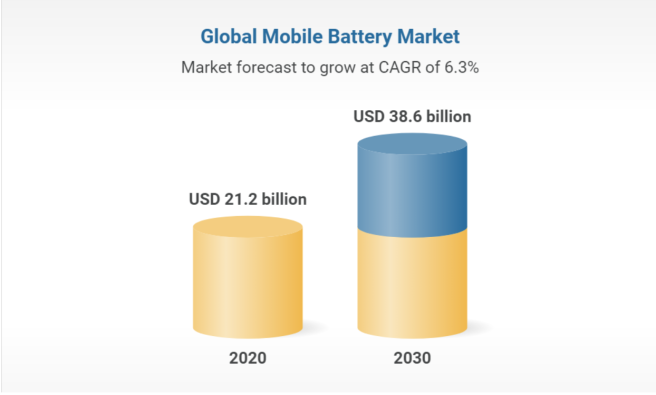It’s always a good idea to keep an eye on the market for new technologies. Especially when it comes to something that could fundamentally shape the future of mobile use. And I think that one industry that might be interested in keeping an eye on is the mobile battery market.
A lot has been done so far to make batteries more powerful, but there is still plenty of room for further innovation and progress. And we could really use that sort of thing when it comes to mobile devices.
According to analysts, we might soon see a boom in the growth of this industry. Thanks to the advent of new, innovative technology and its growing popularity among consumers. And I have no clue how this will affect the market for portable power supplies and chargers, but I do know that there is a lot of money at stake here.
In fact, most industry experts agree that the mobile battery market is set to grow substantially in the next decade or so. Something that many experts say is due to factors such as increased smartphone sales and increasing personal demand for mobile batteries and chargers.
But that’s not it, though. Another factor that could play a big role here is the fact that people are using their smartphones more than ever before. Whether it’s for work or for fun, people simply have no time to waste with their batteries running low. And most don’t want to take any chances by running out of battery on some important call or message. That’s why they are always looking to juice up whenever they can and wherever they can.
So what we’re seeing here is a situation where consumers demand more power and will pay handsomely for anything that can give them just that. Which has undoubtedly led many tech companies to invest in R&D efforts in order to bring mobile batteries one step closer to perfection.
And I think it’s safe to say that there is a rationale behind this move. Especially considering that the market is projected to grow by around $20 billion in the next five years. This is definitely something that battery companies are going to want a cut-off.
And we can’t forget about smartphones and other mobile devices here either. Because they are often what drive consumers to purchase new batteries and other portable power supplies on a regular basis. And there’s no doubt that the market for such things will only continue to grow over time.
The progress of technology is obvious with the fact that people can now carry around so much power in their pockets everywhere they go. Who would’ve thought that such a thing would be possible, just a few years ago? We live in an incredible time, with incredible possibilities at our fingertips. Samsung continuity to work on their battery, as evident from their latest Galaxy Fold 4 which requires double the power for its 7.6inch touchscreen display.
It’s safe to say that mobile batteries are here to stay. And I’m sure we will see more and more companies investing in them in the future. Who knows where this kind of industry might lead us?
Will improved battery life increase declining smartphone sales?
If battery life has long been the Achilles’ heel of many smartphone hardware manufacturers, then you can bet your bottom dollar that improving it will continue to be a key focus for mobiles in the years ahead.
Thanks to Moore’s Law, which states that computing power doubles every two years, we’ve seen our smartphones become exponentially faster in recent years. So much so that some are now using them as no more than glorified personal digital assistants. And this new breed of mobile is starting to cause one big problem for everyone’s favorite piece of hardware: battery efficiency.
In fact, the issue of smartphone battery life has become a hot topic in the tech industry, especially with new devices being released every year. And it’s no wonder why: newer phones require bigger batteries and more powerful processors as they evolve and change.
But here’s the problem: smartphones really aren’t meant to be used as personal computers. Just ask anyone who’s ever been stuck in a meeting or lecture with a dying phone – waiting for it to reach just 5% battery power so they can get some vital information out of the thing. It’s a nightmare scenario that seems to plague smartphone owners everywhere.
But there really is a solution to this problem, and it’s quite simple. We just need to improve the efficiency of our smartphone’s battery power. And that’s exactly what many modern manufacturers are doing as we speak.
In fact, adding just 5% extra battery should be enough to increase the battery life of a phone by an hour or two. Which is a massive leap for such an important area of consumer tech that’s always been in desperate need of improvement.
The key to achieving longer life on our mobiles is improving the process of converting chemical energy into electrical energy. So far, we’ve seen energy conversion rates on mobile batteries improve by roughly 50% over the last decade alone. And this is thanks to the use of new technologies known as “nanomaterials” and “nanoparticles”.
Long story short, these powerful new materials and systems mean that we can now increase battery life significantly. They also allow for a greater deal of customisation when it comes to specific types of batteries. This means that manufacturers can tailor their products for consumers with different needs and budgets.

